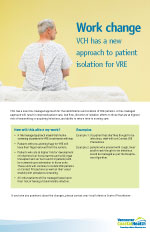Work change: New approach to patient isolation for Vancomycin Resistant Enterococcus (VRE)
We will be starting our VRE risk managed approach to VRE isolation earlier than anticipated. Starting in early February we will be implementing some changes to our current practices. It is important that we continue to roll out the decluttering, mobile equipment cleaning and antimicrobial stewardship programs across VCH. Please note that some cases of VRE still need to be isolated but many do not.
Why are we doing this?
Over the past two years, some Canadian healthcare facilities have decided to reduce or stop screening for Vancomycin Resistant Enterococci (VRE) as well as to stop using Contact Precautions on patients who have been identified as being VRE positive. This has been driven, in part, by a realization that most patients do not develop infections from VRE but are only asymptomatically carrying the organism. It has also been influenced by studies that show that patient isolation may result in reduced quality of care because of decreased visits by healthcare staff and patient feelings of negative “ labelling”. As well, many hospitals are encountering bed allocation pressures and are also concerned about staff developing “isolation fatigue” and subsequently becoming less conscientious with barrier precautions. Stopping isolation in patients at low risk for transmitting infections is potentially beneficial to both patients and hospitals.
The original motivation to manage VRE in a way similar to Methicillin resistant Staphylococcus aureus (MRSA) was because of concerns about transfer of the resistance gene for vancomycin to MRSA which would have left only very toxic antibiotics to treat MRSA. However, 17 years of experience has shown that this phenomenon rarely occurs—and we now have new drugs in our arsenal to treat MRSA infections. Vancouver Coastal Health has reviewed their data on VRE and has found that less than 3% of all of these bacteria cause infections in our patients. Those infections that occur are mainly from the urinary tract and generally not severe in nature.
How will this affect my work?
A risk managed approach means that routine screening of patients for VRE on admission will stop. Patients with pre-existing flags for VRE will have their flags removed from the system. Removal of VRE flags in the PCIS systems has already started. Patients who are at higher risk for development of infections (our bone marrow and solid organ transplant and our burn and ICU patients) will be screened upon admission to those units. These units will continue to isolate VRE patients on Contact Precautions as well as their usual weekly point prevalence screening. All other patients will be managed based upon their risk of having a transmissible infection. Example 1: if a patient has diarrhea thought to be infectious, staff will use Contact (GI) Precautions Example 2: patients who present with cough, fever and/or rash thought to be infectious would be managed as per the Respiratory Algorithm.
A risk-managed approach will result in improved patient care, provide increased resources for other patient care activities, improve bed flow, direction of isolation efforts to those that are at highest risk of transmitting or acquiring infections, and ability to return time to nursing care. An additional benefit will be decreased waste from gloves and laundering of gowns. If you have any questions about the upcoming changes, please contact your local Infection Control Practitioner.


